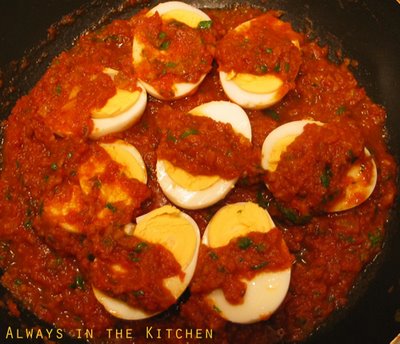 One of my Christmas presents this year was a cookbook by Ethiopian-born Swede Marcus Samuelsson - the beautiful The Soul of a New Cuisine: A Discovery of the Foods and Flavors of Africa. The recipes therein are quite gorgeous, and it was a bit of a chore to decide what to make first. Palle relieved me of that responsibility by deciding to make the Chicken-Peanut Stew (Samuelsson's own take on a classic combination found all over the northwest of Africa, inspired by descriptions from a dishwasher from Mali).
One of my Christmas presents this year was a cookbook by Ethiopian-born Swede Marcus Samuelsson - the beautiful The Soul of a New Cuisine: A Discovery of the Foods and Flavors of Africa. The recipes therein are quite gorgeous, and it was a bit of a chore to decide what to make first. Palle relieved me of that responsibility by deciding to make the Chicken-Peanut Stew (Samuelsson's own take on a classic combination found all over the northwest of Africa, inspired by descriptions from a dishwasher from Mali).Classically, the dish would be served with yellow rice, we are told, but in the interests of keeping things simple, we opted for straight-forward basmati, steamed up in the rice-cooker untended, while Palle chopped, prepped and sauteed his way through the making of the dish.
We had shopped earlier that day, down at Granville Island market, a known source of fiesty scotch bonnet and habanero chiles, which the recipe calls for. We used two, trimming out the seeds and much of the incendiary pith, but the resulting dish was not as fiery as, for example, Palle's Jerk Chicken, which has been known to almost blind dinner guests. As you may guess, the man likes his fierce food.
The stew had spinach in it, which I am not accustomed to having in any other iteration of chicken and peanut stew. It was, however, a beautiful and perfect ingredient - added just at the last minute and stirred through, so it stayed jewel-bright and fresh tasting, and that single element really elevated the dish into something special. I particularly liked that, unlike many one-pot meals, this one had a variety of textures and a very well-balanced approach to starch and protein, and vegetables. While the recipe called for a combination of chicken breast and thigh, after making it that way I once again decided that stewed chicken should be all dark meat, whereever possible. It just gives itself over to the task that much better, staying juicy even in large chunks, browning beautifully when sauteed, and having a lot of flavour. For the small increase in fat to be found in the thighs, I'll take them over breast meat in most simmered dishes.
We both really liked the dish, although a couple of changes may be in order. The aforementioned all-thigh approach definitely strikes my fancy, and also, the amount of liquid seems a little higher than I thought ideal, especially for a stew as opposed to a soup. This is the sort of thing that can be very hard to gauge the first time one does a recipe, and moreso in a recipe like this where cooked onions and carrots are pureed into the liquid. Still, it's a good thing to note and adjust on a re-visit.
There are a lot of other dishes I want to try, in this book. There's an outstanding-looking lamb and chickpea sandwich, and a recipe for homemade merguez sausage - made into meatballs. That sounds just about perfect, to me, so I'm really looking forward to making it. I just need to decide what to serve with them...I suspect they are next on the list.


























